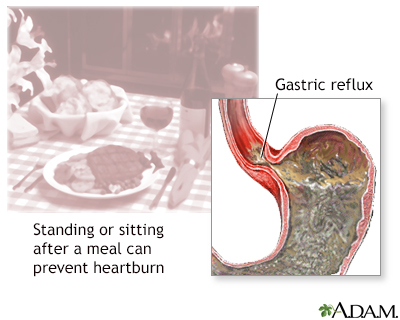Pregnancy SmartSiteTM
Cancer - esophagus DefinitionEsophageal cancer is cancer that starts in the esophagus. This is the tube through which food moves from the mouth to the stomach. CausesEsophageal cancer is not common in the United States. It occurs most often in men over age 50 years. There are two main types of esophageal cancer, squamous cell carcinoma and adenocarcinoma. These two types look different from each other under the microscope. Squamous cell esophageal cancer is linked to smoking and drinking too much alcohol. Adenocarcinoma is the more common type of esophageal cancer. Having Barrett esophagus increases the risk for this type of cancer. Acid reflux disease (gastroesophageal reflux disease, or GERD) can develop into Barrett esophagus. Other risk factors include smoking, being male, or being obese. SymptomsSymptoms may include any of the following:
Exams and TestsTests used to help diagnose esophageal cancer may include:
Stool testing may show small amounts of blood in the stool. TreatmentEGD will be used to obtain a tissue sample from the esophagus to diagnose cancer. When the cancer is only in the esophagus and has not spread, surgery may be done. The cancer and part, or all, of the esophagus is removed. The surgery may be done using:
Radiation therapy may also be used instead of surgery in some cases when the cancer has not spread outside the esophagus. Either chemotherapy, radiation, or both may be used to shrink the tumor and make surgery easier to perform. If the person is too ill to have major surgery or the cancer has spread to other organs, chemotherapy or radiation may be used to help reduce symptoms. This is called palliative therapy. In such cases, the disease is usually not curable. Besides a change in diet, other treatments that may be used to help the patient swallow include:
Support GroupsYou can ease the stress of illness by joining a cancer support group. Sharing with others who have common experiences and problems can help you not feel alone Outlook (Prognosis)When the cancer has not spread outside the esophagus, surgery may improve the chance of survival. When the cancer has spread to other areas of the body, a cure is generally not possible. Treatment is directed toward relieving symptoms. Possible ComplicationsComplications may include:
When to Contact a Medical ProfessionalContact your health care provider if you have difficulty swallowing with no known cause and it does not get better. Also contact your provider if you have other symptoms of esophageal cancer. PreventionTo reduce your risk of cancer of the esophagus:
ReferencesAjani JA, D'Amico TA, Bentrem DJ. Esophageal and esophagogastric junction cancers, version 2.2023, NCCN clinical practice guidelines in oncology. J Natl Compr Canc Netw. 2023;21(4): 393-422. PMID: 37015332 pubmed.ncbi.nlm.nih.gov/37015332/. Ku GY, Ilson DH. Cancer of the esophagus. In: Niederhuber JE, Armitage JO, Kastan MB, Doroshow JH, Tepper JE, eds. Abeloff's Clinical Oncology. 6th ed. Philadelphia, PA: Elsevier; 2020:chap 71. National Cancer Institute website. Esophageal cancer treatment (PDQ) - health professional version. www.cancer.gov/types/esophageal/hp/esophageal-treatment-pdq. Updated May 11, 2023. Accessed August 9, 2023. | ||
| ||
Review Date: 8/7/2023 Reviewed By: Michael M. Phillips, MD, Emeritus Professor of Medicine, The George Washington University School of Medicine, Washington, DC. Also reviewed by David C. Dugdale, MD, Medical Director, Brenda Conaway, Editorial Director, and the A.D.A.M. Editorial team. View References The information provided herein should not be used during any medical emergency or for the diagnosis or treatment of any medical condition. A licensed medical professional should be consulted for diagnosis and treatment of any and all medical conditions. Links to other sites are provided for information only -- they do not constitute endorsements of those other sites. No warranty of any kind, either expressed or implied, is made as to the accuracy, reliability, timeliness, or correctness of any translations made by a third-party service of the information provided herein into any other language. © 1997- A.D.A.M., a business unit of Ebix, Inc. Any duplication or distribution of the information contained herein is strictly prohibited. | ||


 Digestive system
Digestive system Heartburn preventi...
Heartburn preventi... Esophageal cancer
Esophageal cancer
